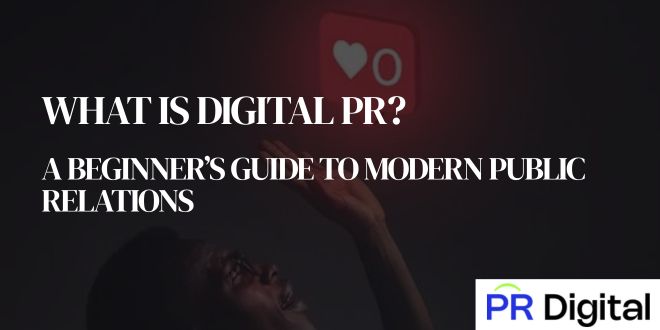

What Is Digital PR? A Beginner’s Guide to Modern Public Relations
Public relations has always been about shaping perception, but the ways we influence that perception have changed dramatically. Enter Digital PR—a discipline that merges the storytelling principles of traditional PR with the speed, data, and interactivity of the internet. Whether you work for a multinational brand or a small creative studio, understanding Digital PR is now essential for breaking through the online noise and reaching audiences on their own turf.
Why Traditional PR Needed an Upgrade
Newspapers, trade magazines, and broadcast TV once ruled the media world. In that environment, pitching a single journalist often meant access to millions of readers or viewers. Today, news breaks first on Twitter, thought-leaders publish on LinkedIn, and customers leave product reviews on TikTok for the whole world to see. That fragmentation forced communicators to rethink everything from headline writing to crisis management.
From Press Releases to Tweets
In the pre-digital era, press releases were faxed or emailed to a handful of editors. Now, a tweet can do the same job in 280 characters—while also generating instant feedback in the form of likes, shares, or heated comment threads. Digital PR retains the cornerstone practices of research, messaging, and relationship-building, but adapts them to real-time platforms where conversations never sleep.
So, What Exactly Is Digital PR?
Digital PR is the practice of earning media coverage, backlinks, and brand mentions across online channels to build visibility, credibility, and search authority. It sits at the crossroads of traditional media outreach, content marketing, SEO, and social media engagement. The goal is to place your narrative where your audience already consumes information—whether that’s a business podcast, an influential blog, or the top of Google’s search results.
Core Components of Digital PR
A modern Digital PR program usually blends several moving parts:
- Online Media Relations: Identifying journalists, niche bloggers, and podcasters who influence your market, then providing them with relevant, newsworthy angles.
- Content Assets: Data reports, white papers, interactive infographics, or short-form videos that journalists and creators want to reference or embed.
- Social Amplification: Coordinating announcement dates with social teams, paid media, and influencer partners for maximum momentum.
- SEO Link Building: Securing backlinks from high-authority publishers to improve organic search rankings and drive referral traffic.
- Real-Time Monitoring: Tracking brand mentions, competitor buzz, and trending topics so you can join the conversation while it’s hot.
Each component can be run as a standalone tactic, yet the magic happens when they operate in sync—turning a simple story idea into a multi-channel splash.
How Digital PR Works in Practice
Building Relationships in the Online Space
Reporters and content creators receive hundreds of pitches daily. To stand out, Digital PR pros invest time in genuine relationship-building—commenting on journalists’ work, sharing their articles, or offering fresh data they can use in future coverage. Over time, these micro-interactions foster trust, making editors more receptive when you eventually pitch a story.
Tools and Platforms You’ll Lean On
While charisma and storytelling are timeless skills, Digital PR thrives on technology. Popular tools include:
- Media Databases (e.g., Muck Rack): For finding contact details and editorial preferences.
- Social Listening Platforms (e.g., Brandwatch): To spot emerging trends before competitors pounce.
- Outreach Automation (e.g., BuzzStream): For personalizing large batches of emails without sounding robotic.
- SEO Suites (e.g., Ahrefs): To gauge domain authority and track backlink value.
- Analytics Dashboards (e.g., Google Data Studio): For blending campaign metrics into a single, eye-pleasing report.
- Artificial Intelligence & LLMs: Using AI to help scale Digital PR efforts has its pros and cons that should be weighed heavily.
Knowing which tool to deploy—and when—helps keep campaigns nimble and measurable.
Measuring Success in Digital PR
Vanity metrics like raw impressions can be tempting but misleading. Savvy practitioners focus on indicators tied to business outcomes:
- Referral Traffic: Click-throughs generated by earned media links.
- Domain Authority Growth: How much each new backlink boosts overall SEO strength.
- Share of Voice: Percentage of brand mentions versus competitors in targeted conversations.
- Engagement Quality: Average time on page, social sentiment, and comments per post.
- Conversion Impact: How many leads, sign-ups, or sales stem from PR-driven visitors.
By aligning metrics with organizational objectives—whether that’s lead generation or reputation management—Digital PR validates its seat at the strategic table.
Getting Started: A Beginner’s Roadmap
If you’re new to Digital PR, the process can feel overwhelming. A structured roadmap keeps things manageable:
- Audit Your Current Footprint: List existing media mentions, backlinks, and social chatter to establish a baseline.
- Define Clear Objectives: Is your priority thought leadership, product launches, or SEO authority? Goals shape tactics.
- Craft Shareable Assets: Commission a survey, crunch internal data, or repurpose a slide deck into an infographic—give journalists something unique.
- Build a Target List: Segment contacts by topic, outlet type, and audience overlap. Quality beats quantity.
- Personalize Pitches: Show you’ve read the journalist’s latest piece and explain why your story adds value.
- Amplify Everywhere: Coordinate with content, paid media, and influencer partners so your message appears in multiple feeds simultaneously.
- Measure, Learn, Optimize: Review analytics weekly, celebrate small wins, and refine everything from subject lines to call-to-action wording.
Following these steps not only jump-starts a campaign but also cultivates the habits that separate reactive promotion from strategic Digital PR.
The Bottom Line
Digital PR isn’t a buzzword; it’s the natural evolution of public relations in an always-connected world. By weaving traditional storytelling into data-driven outreach, brands earn coverage that ranks on Google, resonates on social media, and ultimately drives real business results.
Whether you’re pitching a tech reporter on Slack, briefing a TikTok creator over Zoom, or sharing a data study on LinkedIn, the principles remain the same: be relevant, be timely, and above all, be helpful. Commit to those values, and your Digital PR efforts will not only secure headlines but also cultivate lasting credibility in the digital age.
- Digital PR vs Traditional PR: Key Differences and Benefits - June 18, 2025
- What Is Digital PR? A Beginner’s Guide to Modern Public Relations - June 8, 2025
- Why Digital PR is the New SEO - June 6, 2025



